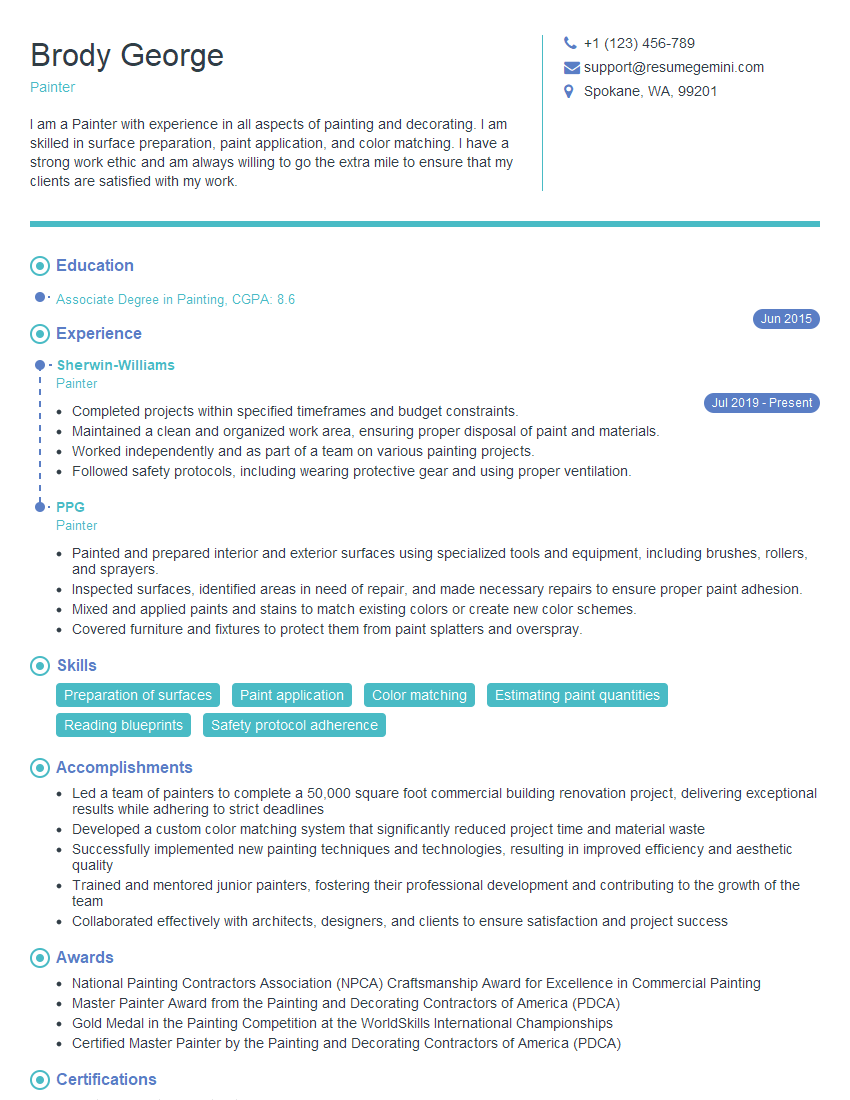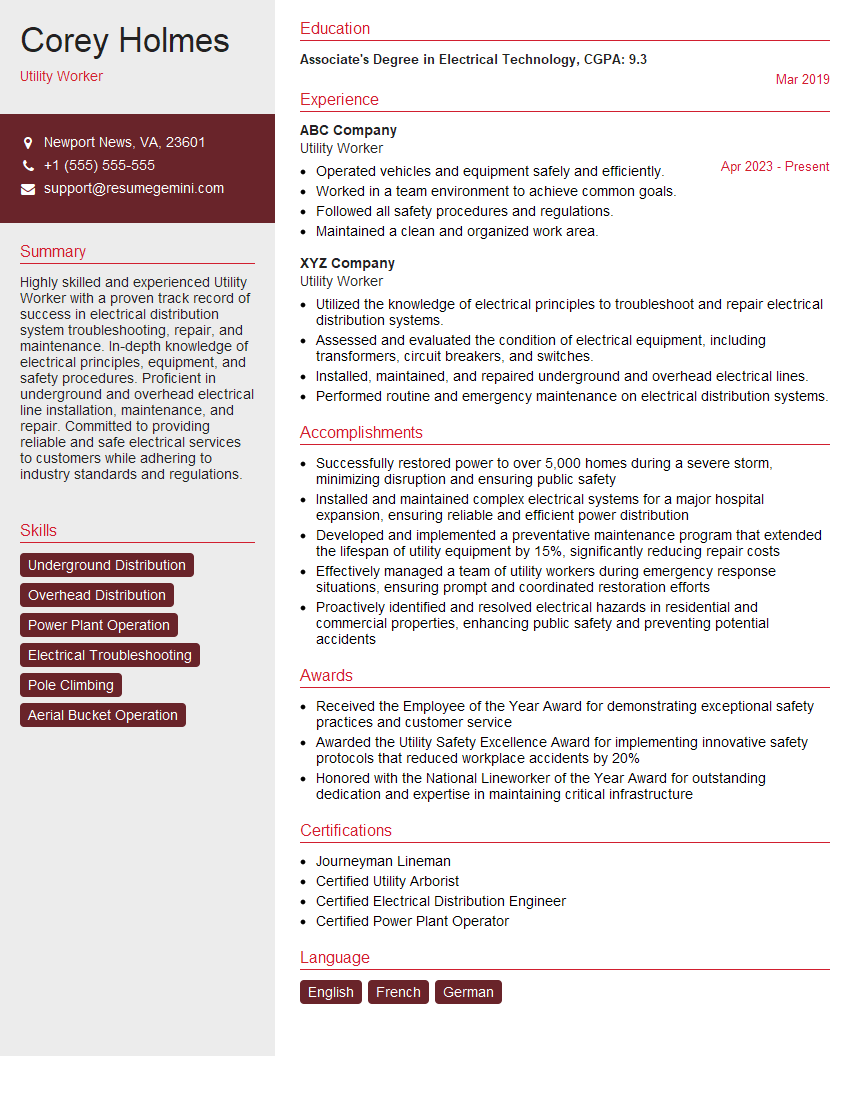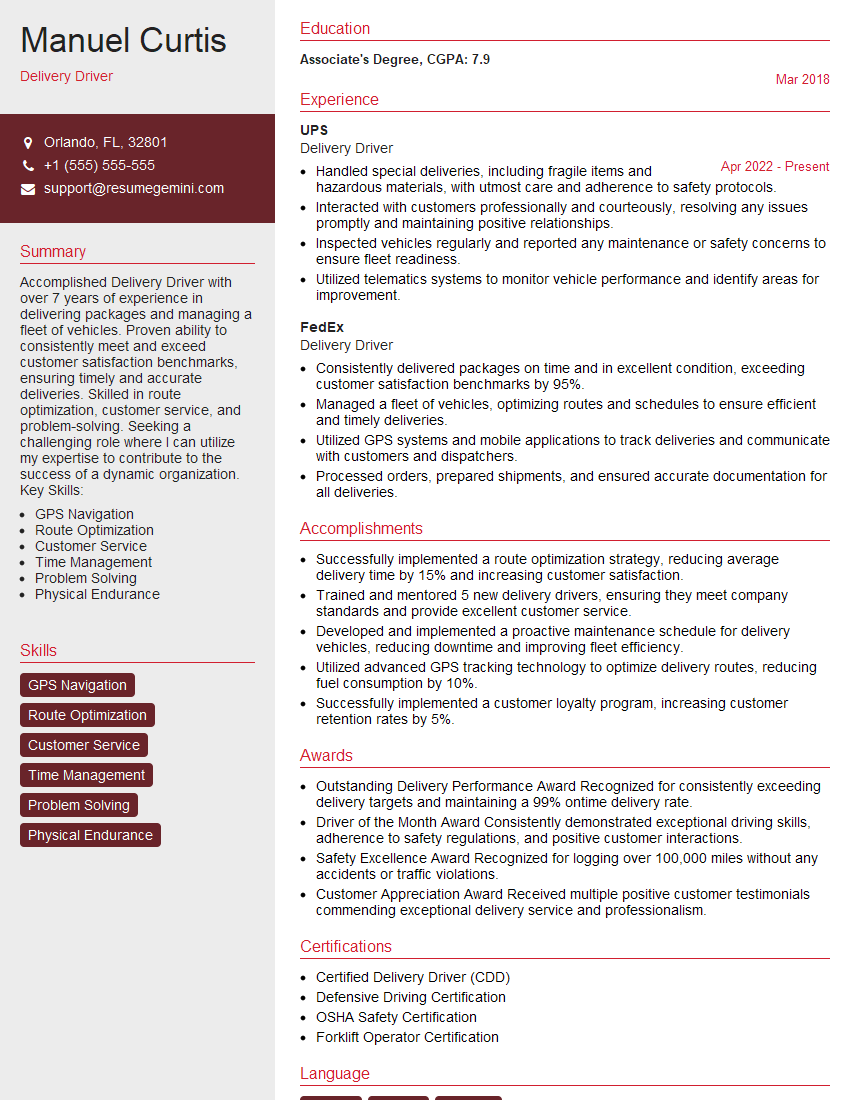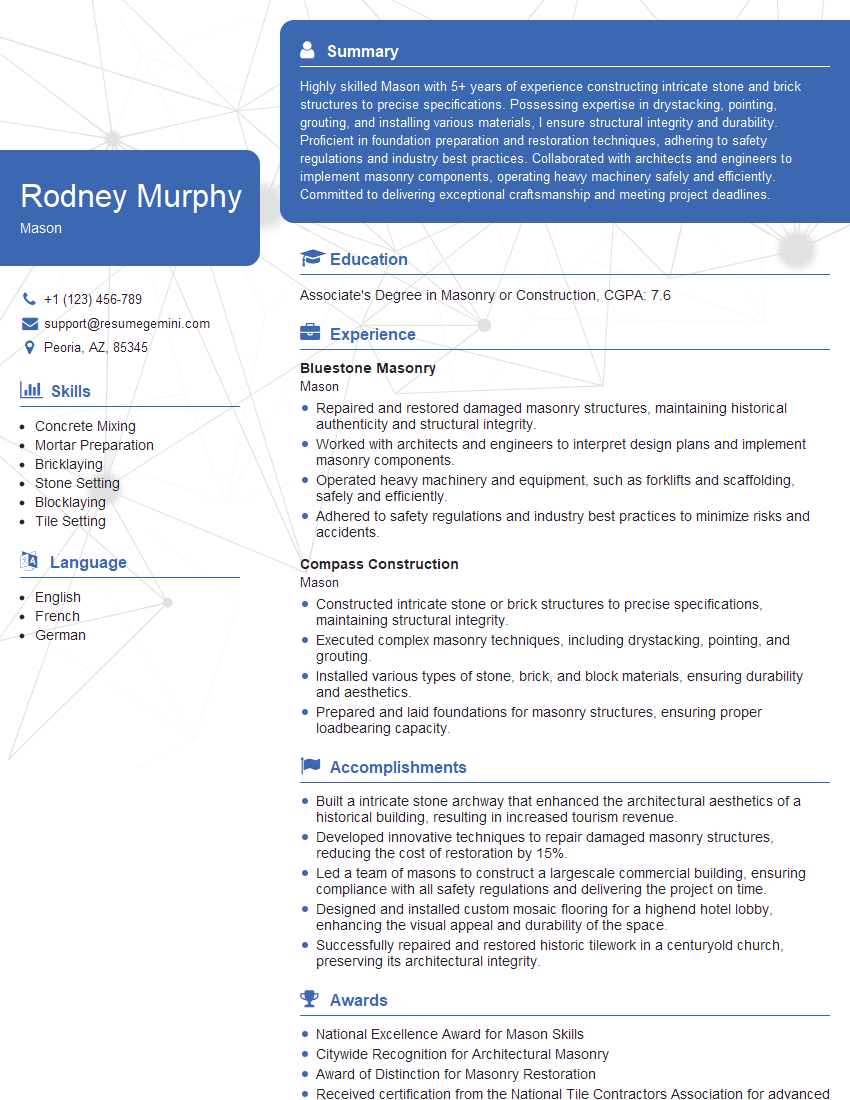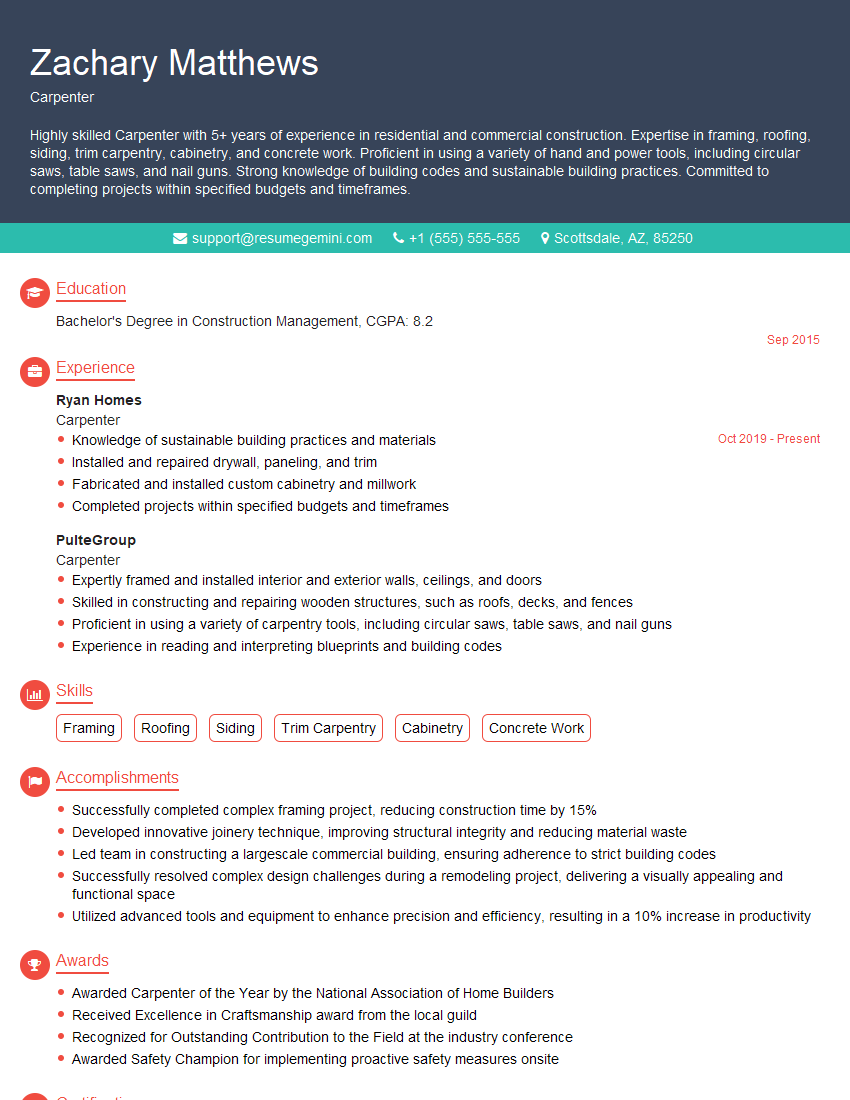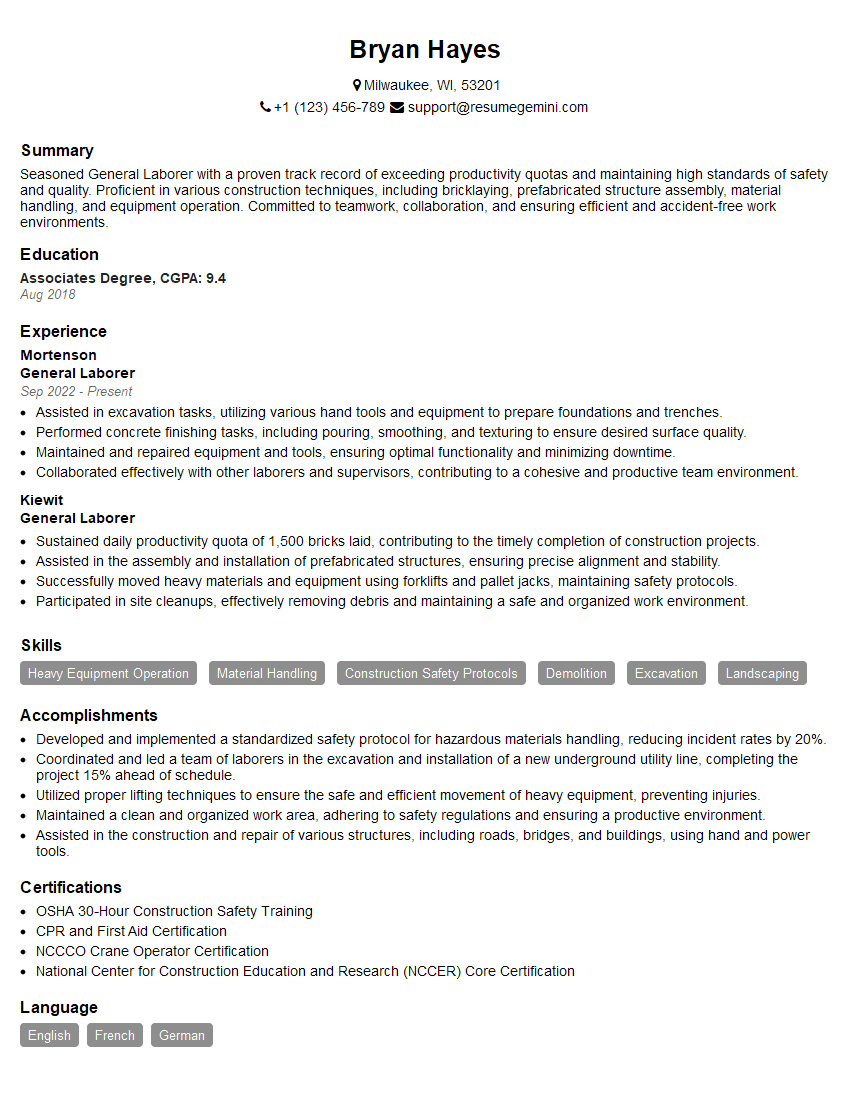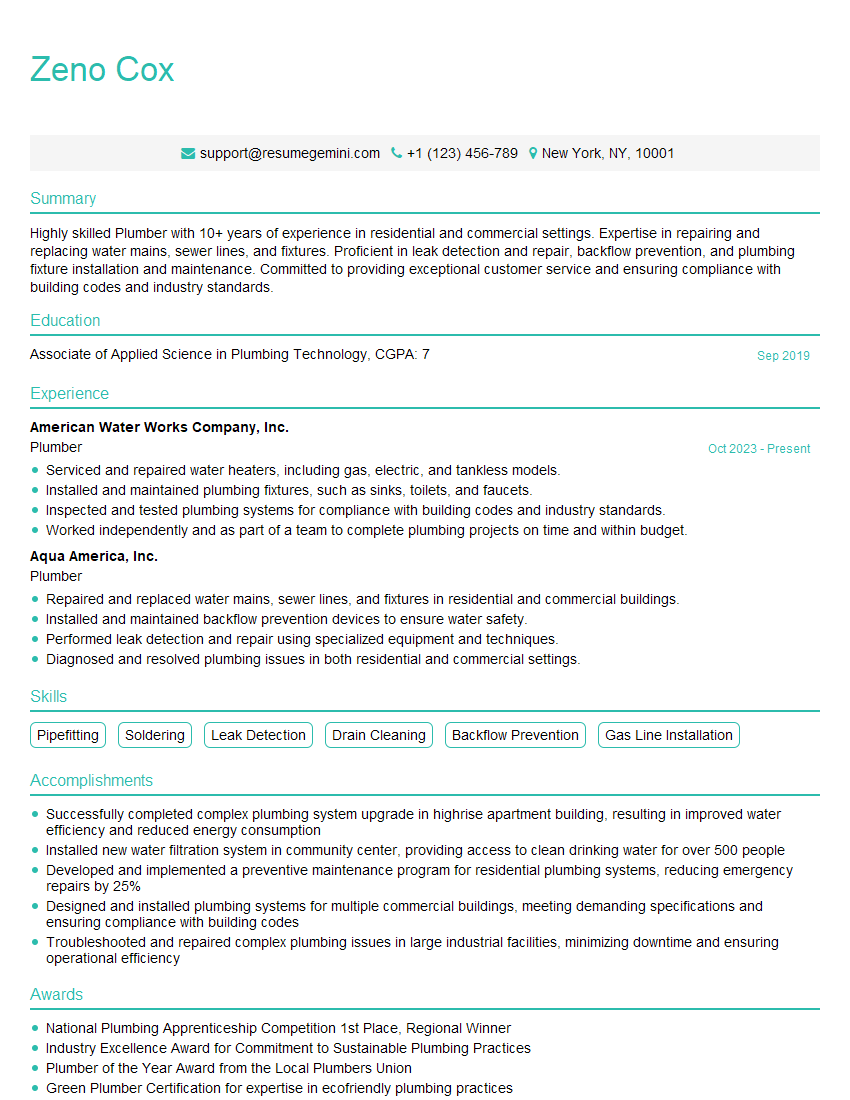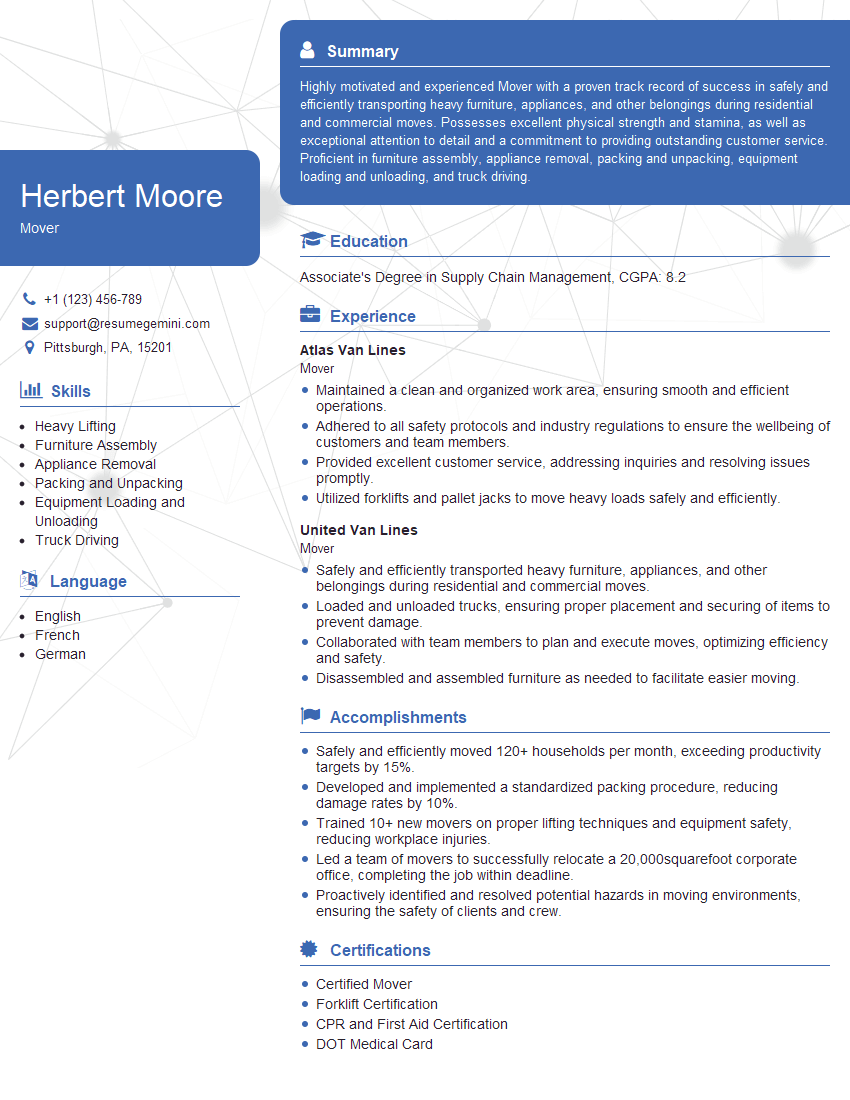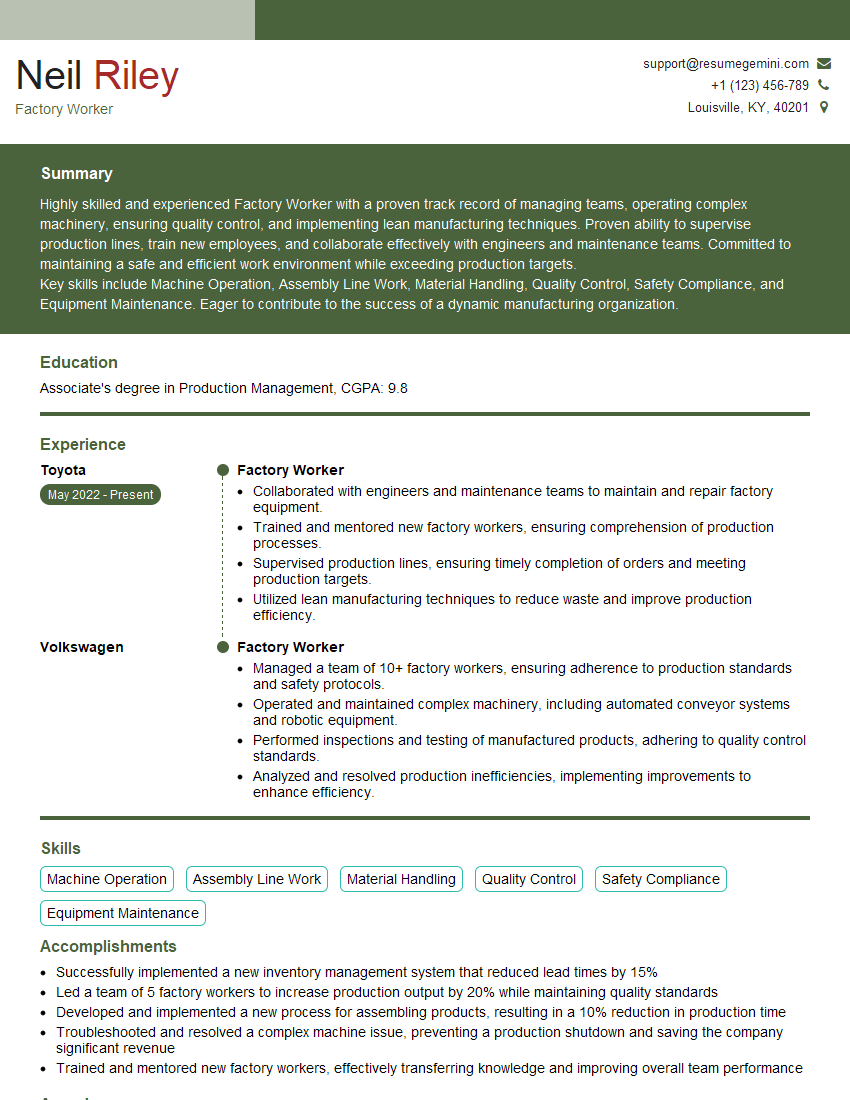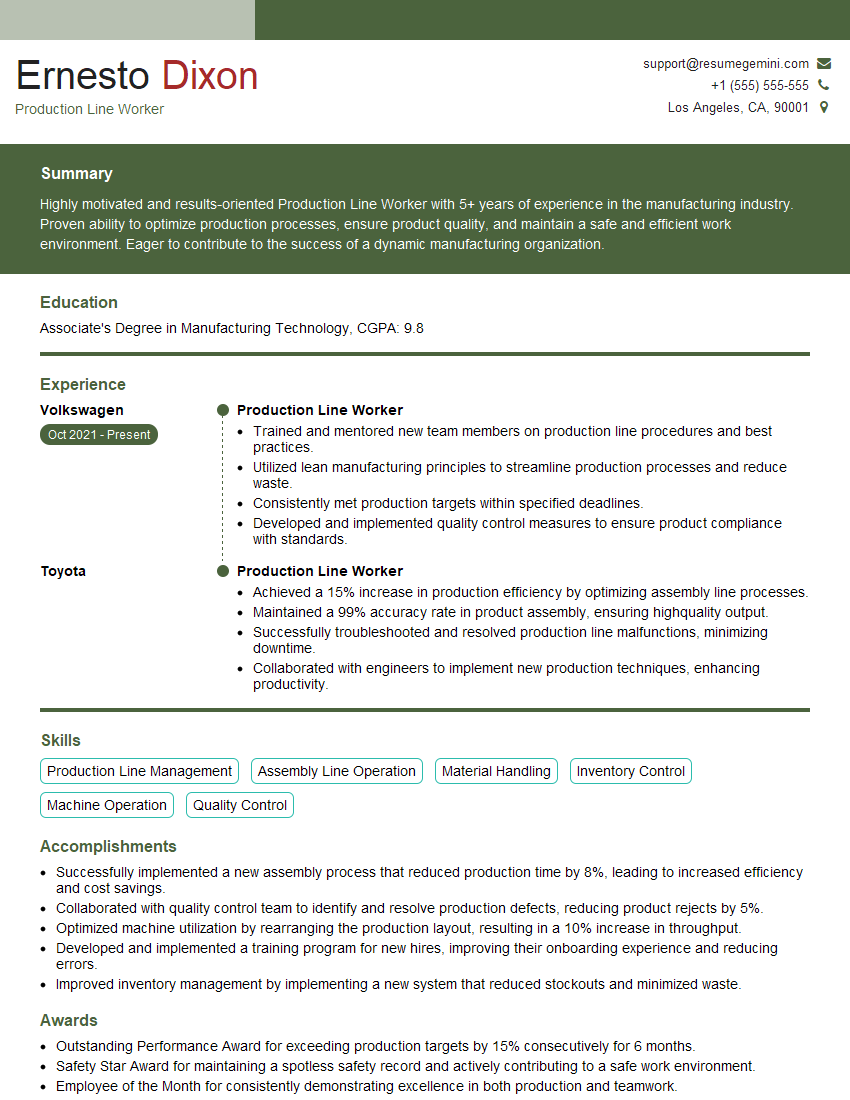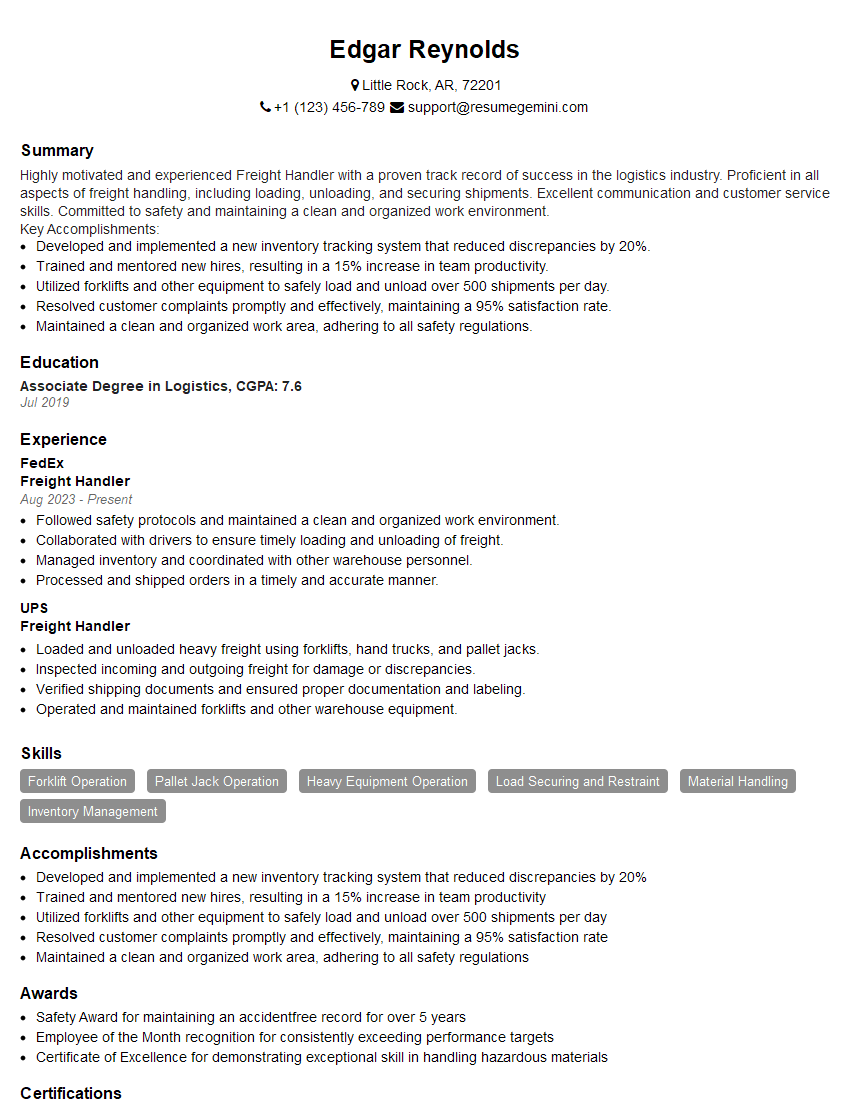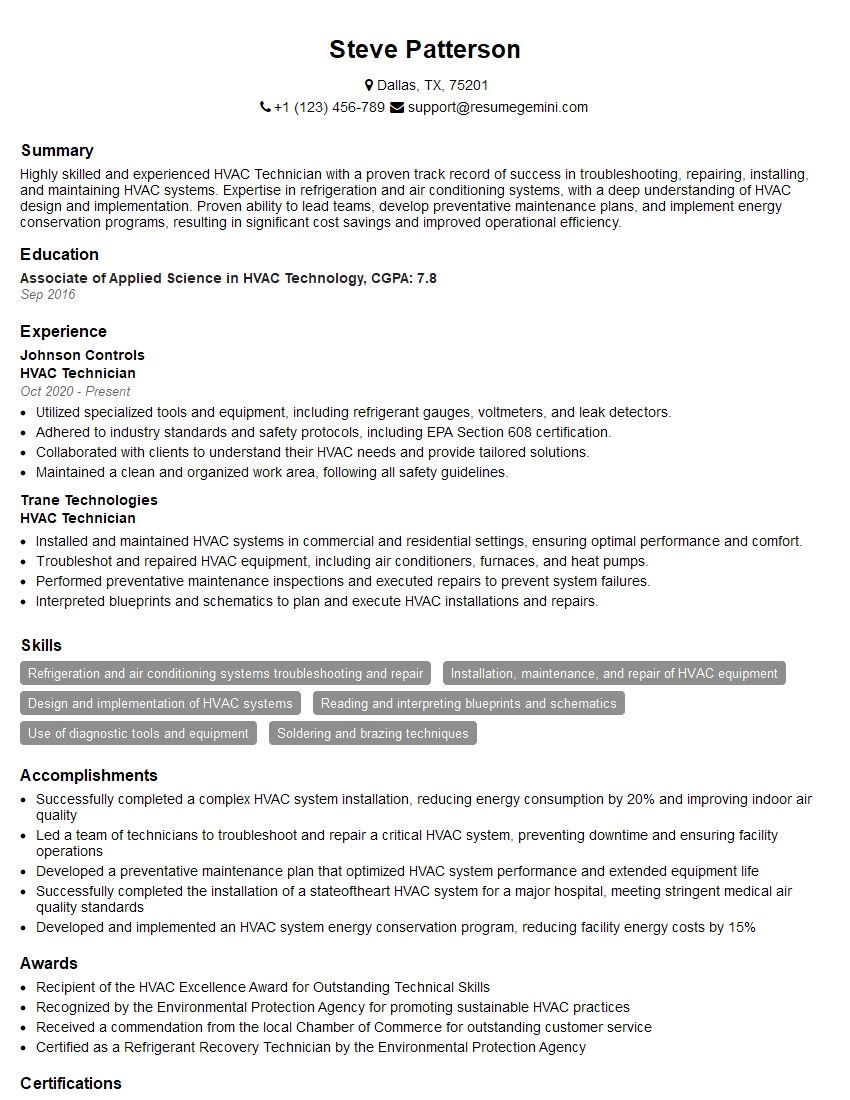Interviews are opportunities to demonstrate your expertise, and this guide is here to help you shine. Explore the essential Comfortable with physical labor interview questions that employers frequently ask, paired with strategies for crafting responses that set you apart from the competition.
Questions Asked in Comfortable with physical labor Interview
Q 1. Describe your experience handling heavy objects (weight specifics preferred).
Throughout my career, I’ve regularly handled objects ranging from 25 to 75 pounds on a consistent basis, and occasionally up to 150 pounds with proper lifting techniques and assistance when needed. For example, in my previous role at Acme Construction, I frequently moved stacks of bricks, each weighing approximately 40 pounds, loading and unloading them from trucks and placing them precisely where needed for construction. Similarly, I’ve maneuvered heavy equipment parts, such as 75-pound steel beams, requiring careful coordination and balance. When faced with heavier items, I always prioritize teamwork and utilize proper lifting equipment such as pallet jacks or forklifts to ensure safety and efficiency.
Q 2. What is your experience with repetitive motion tasks?
Repetitive motion tasks are a significant part of many physically demanding jobs, and I have extensive experience managing them. For instance, during my time at Green Valley Landscaping, I spent many hours using a shovel and wheelbarrow, which involves repetitive lifting, bending, and carrying motions. To combat the risks associated with repetitive strain, I’ve learned to employ proper posture, regular breaks, and stretching exercises. This proactive approach has significantly reduced my risk of injury and helped maintain my productivity levels. I believe in the importance of listening to your body and taking necessary precautions to prevent cumulative trauma injuries.
Q 3. What safety measures do you employ when lifting heavy objects?
Safety is paramount when lifting heavy objects. My approach is always based on these key principles:
- Proper Posture: I maintain a straight back and bend at the knees, keeping the object close to my body to reduce strain. Imagine holding a heavy suitcase – you wouldn’t bend over at the waist, right? You’d bend your knees.
- Firm Grip: I ensure a secure grip on the object to prevent slips or drops.
- Stable Base: I maintain a balanced stance with my feet apart, providing a wide and stable base of support.
- Lifting Assistance: When handling items exceeding my comfortable weight limit, I always seek assistance or utilize appropriate mechanical aids like dollies or hand trucks.
- Clear Path: Before lifting, I clear the path to avoid obstacles and ensure a smooth lift. Trips and falls are a major safety concern.
These precautions help to minimize the risk of muscle strains, back injuries, and other lifting-related hazards.
Q 4. How do you maintain your physical stamina during long shifts?
Maintaining physical stamina during long shifts requires a multi-pronged approach:
- Hydration: I consistently drink plenty of water throughout the day to avoid dehydration.
- Nutrition: I consume regular, healthy meals and snacks to maintain energy levels. This avoids the energy crash that can result from skipping meals.
- Proper Rest: I take short breaks to rest and stretch, preventing fatigue. It’s crucial to avoid pushing yourself too hard without giving your body appropriate time to recover.
- Physical Fitness: Maintaining a reasonable level of fitness outside of work helps build strength and endurance, making long shifts more manageable.
By following this regime, I’ve found I can maintain productivity and avoid exhaustion even during the most demanding days.
Q 5. Describe a time you had to work in challenging weather conditions.
During a roofing project last summer, we experienced several days of extreme heat and humidity. The temperatures soared to over 95 degrees Fahrenheit with high humidity, creating challenging conditions for all of us. To cope, we adjusted our work schedule to focus on cooler parts of the day, took more frequent breaks in the shade, and increased our water intake. We also wore light-colored clothing and utilized sunscreen to protect ourselves from the sun. Safety was our priority; we closely monitored each other for signs of heat exhaustion and made sure everyone stayed hydrated and took necessary breaks. This experience highlighted the importance of adapting to changing conditions and prioritizing safety in extreme weather.
Q 6. Have you ever experienced a workplace injury related to physical labor? If so, describe the situation and measures taken.
Yes, early in my career I suffered a minor sprain while moving heavy boxes improperly. It was a valuable lesson. I immediately reported the injury to my supervisor and sought medical attention. This resulted in a few days of rest and physical therapy. The experience reinforced the importance of using proper lifting techniques and always prioritizing safety over speed. I now actively share my experience with colleagues to emphasize the need for safe working practices and the consequences of neglecting them.
Q 7. What is your experience with power tools (list specifics)?
I am proficient in the safe and effective use of several power tools, including:
- Circular Saw: I’m experienced in using various blades for different materials and understand safety protocols, like blade guards and kickback prevention.
- Drill Press: I can accurately drill holes in a variety of materials using different drill bits, ensuring safe operating procedures.
- Impact Wrench: I frequently use this tool for fastening and loosening bolts and nuts, particularly in construction settings. Safety glasses and hearing protection are paramount.
- Chainsaw: I have training and experience operating chainsaws, and I always adhere to safety guidelines, including proper blade maintenance and personal protective equipment.
I always prioritize safety by using the correct personal protective equipment, understanding the limitations of each tool, and carefully inspecting tools before use. My experience encompasses the full range of tools typically used in construction and landscaping.
Q 8. What is your experience with hand tools (list specifics)?
My experience with hand tools is extensive and spans a variety of applications. I’m proficient in using tools for various tasks, from basic carpentry to more specialized projects. For instance, I’m comfortable using:
- Measuring and marking tools: Tape measures, marking gauges, speed squares, levels.
- Cutting tools: Handsaws (various types), circular saws (with appropriate safety measures), chisels, planes.
- Fastening tools: Hammers, screwdrivers (Phillips and flathead), wrenches (adjustable and socket), drills, and impact drivers.
- Other hand tools: Pliers (various types), screwdrivers (various types), wire strippers, utility knives.
I understand the importance of maintaining tools properly – keeping them sharp, clean, and stored correctly for optimal performance and safety. For example, I always inspect my tools before starting any job to ensure they’re in good working order and free from damage.
Q 9. Describe your experience with operating machinery (list specifics).
My experience with machinery includes operating various types of equipment, always prioritizing safety and proper training. I’ve operated:
- Forklifts: I possess a valid forklift certification and am experienced in safe operation, including load securing, maneuvering in tight spaces, and pre-operation checks.
- Skid steers: I’m familiar with operating skid steers for tasks such as material handling and ground preparation. Safety procedures, including maintaining a safe distance from bystanders, were strictly adhered to.
- Mini excavators: My experience with mini excavators includes excavation, trenching, and backfilling. I understand the importance of adhering to safe operating procedures and understanding ground conditions.
In all cases, I meticulously follow all safety protocols, including pre-operational checks and maintaining awareness of my surroundings. For instance, before operating a forklift, I always perform a thorough inspection of the equipment, checking fluids, tires, and safety mechanisms before commencing any work.
Q 10. What is your understanding of workplace safety regulations?
My understanding of workplace safety regulations is comprehensive. I’m familiar with OSHA (Occupational Safety and Health Administration) guidelines and best practices for various industries. This includes:
- Personal Protective Equipment (PPE): I know the importance of using appropriate PPE, including hard hats, safety glasses, gloves, hearing protection, and steel-toed boots depending on the task at hand.
- Hazard identification and mitigation: I am trained in identifying potential hazards in the workplace, such as electrical hazards, trip hazards, and material handling risks. I understand how to mitigate these risks through proper procedures and the use of safety equipment.
- Emergency procedures: I’m familiar with emergency procedures, including reporting accidents and injuries, using fire extinguishers, and knowing evacuation routes.
- Lockout/Tagout procedures: I’m proficient in lockout/tagout procedures to ensure equipment is safely shut down before maintenance or repair.
Safety is not just a set of rules; it’s a mindset. I believe a proactive approach to safety is crucial, and I’m always vigilant about identifying and addressing potential hazards.
Q 11. How do you handle physical discomfort or fatigue on the job?
Physical discomfort and fatigue are inevitable in physically demanding jobs. My approach to managing these involves a combination of strategies:
- Proper posture and lifting techniques: I prioritize using proper lifting techniques to minimize strain on my back and other muscles. This includes bending at the knees, keeping the load close to my body, and avoiding twisting motions.
- Regular breaks and hydration: I take regular breaks to rest and rehydrate, which helps to prevent fatigue and reduces the risk of injury.
- Stretching and exercise: I incorporate regular stretching before and after work, and I maintain an active lifestyle outside of work to build strength and endurance.
- Listening to my body: I pay attention to my body’s signals. If I experience pain or discomfort, I take a break or modify my work approach.
Preventing injuries is paramount. By implementing these strategies, I can maintain my physical well-being and work efficiently throughout the day. For example, during a long day of digging, I make sure to take frequent short breaks, ensuring proper hydration and stretching to avoid muscle cramps or back strain.
Q 12. Describe your experience working as part of a team on physically demanding tasks.
Teamwork is essential in physically demanding jobs. My experience working in teams on physically demanding tasks has been very positive. I’ve learned the importance of:
- Communication: Clear and consistent communication is critical for coordinating tasks and ensuring safety. I actively participate in team discussions and provide input when needed.
- Collaboration: I readily assist my colleagues and work together to accomplish shared goals. We often support each other physically during demanding tasks, such as lifting heavy objects.
- Mutual respect: I treat all my colleagues with respect and appreciate their contributions to the team’s success.
During a recent project involving heavy landscaping, our team worked seamlessly together. We rotated tasks, ensured everyone had sufficient breaks, and actively communicated our progress and any safety concerns. This collaborative approach resulted in a highly efficient and successful project completion.
Q 13. How would you handle a situation where a coworker is not following safety protocols?
If I observed a coworker not following safety protocols, I would address the situation with care and professionalism. My approach would depend on the severity of the infraction:
- Minor infractions: For minor infractions, I would approach my coworker privately and respectfully remind them of the appropriate safety protocol. I would explain the potential risks and offer assistance if needed.
- Serious infractions: For more serious violations that pose an immediate safety risk, I would immediately inform my supervisor or foreman. The safety of myself and my coworkers is paramount.
My goal is to ensure a safe work environment for everyone, and I believe direct and respectful communication is the best way to address safety concerns.
Q 14. What is your preferred method for staying hydrated and energized throughout the workday?
Staying hydrated and energized throughout the workday is crucial for maintaining performance and preventing fatigue. My strategy involves:
- Consistent hydration: I carry a reusable water bottle and consistently sip water throughout the day. I aim to drink water proactively rather than waiting until I feel thirsty.
- Nutritious snacks: I pack healthy snacks, such as fruits, vegetables, or nuts, to maintain energy levels and avoid energy crashes. Sugary snacks and processed foods are avoided as they lead to mid-afternoon slumps.
- Balanced meals: I eat regular, balanced meals to provide sustained energy.
This approach helps me stay alert, focused, and productive throughout the entire workday. I’ve found that small, consistent steps towards hydration and healthy snacking have a massive impact on my overall energy and productivity.
Q 15. How would you assess the risk involved in a physically demanding task before beginning?
Assessing risk in physically demanding tasks involves a systematic approach. I begin by thoroughly reviewing the job description, identifying all potential hazards. This includes considering factors like the weight of materials handled, repetitive movements, awkward postures, environmental conditions (temperature, weather), and the use of machinery or tools.
Next, I perform a site-specific risk assessment, observing the work area for potential trip hazards, uneven surfaces, or obstructions. I also consider my own physical capabilities and limitations. For example, if a task involves prolonged lifting, I’d assess my current physical strength and stamina, and if necessary, request appropriate lifting aids. Finally, I develop a mitigation plan, incorporating safety measures like using proper lifting techniques, wearing appropriate personal protective equipment (PPE), and taking regular breaks to avoid fatigue. This assessment is a continuous process; I regularly review the risk factors as the task progresses.
Career Expert Tips:
- Ace those interviews! Prepare effectively by reviewing the Top 50 Most Common Interview Questions on ResumeGemini.
- Navigate your job search with confidence! Explore a wide range of Career Tips on ResumeGemini. Learn about common challenges and recommendations to overcome them.
- Craft the perfect resume! Master the Art of Resume Writing with ResumeGemini’s guide. Showcase your unique qualifications and achievements effectively.
- Don’t miss out on holiday savings! Build your dream resume with ResumeGemini’s ATS optimized templates.
Q 16. Describe your problem-solving skills when dealing with unexpected physical challenges.
My problem-solving approach to unexpected physical challenges centers on adaptability and resourcefulness. If, for example, a piece of equipment malfunctions mid-task, hindering my progress, I wouldn’t simply stop. I would first assess the situation, checking for immediate safety risks. Then, I’d explore alternative solutions. This could involve using different tools, modifying my approach to the task, or seeking assistance from colleagues. If the problem is beyond my immediate capabilities, I would report it to my supervisor, providing a clear description of the issue and the steps I’ve already taken. I always prioritize safety and efficiency when devising solutions. For instance, if lifting a heavy object proves too difficult due to an unexpected obstacle, I would immediately find a way to reduce the load or get help instead of risking injury.
Q 17. What are your strategies for preventing workplace injuries?
Preventing workplace injuries is paramount. My strategies are multifaceted. First, I always prioritize proper training and understanding of safety procedures before starting any task. This includes knowing how to use equipment correctly, understanding safety protocols specific to the workplace, and practicing safe lifting techniques. Second, I maintain a proactive approach to safety, consistently checking for potential hazards and reporting any unsafe conditions. This might involve reporting damaged equipment, slippery surfaces, or inadequate lighting. Third, I use appropriate PPE consistently, which may include safety glasses, gloves, hard hats, steel-toe boots, and hearing protection depending on the task. Fourth, I take regular breaks to avoid fatigue, which significantly increases the risk of injuries. Fifth, I ensure I’m physically fit and adequately hydrated for the demands of the job. I believe that personal responsibility and a collaborative safety culture are essential to injury prevention.
Q 18. What is your experience with working at heights?
I have extensive experience working at heights, having completed certified training in fall protection and rescue techniques. My experience includes working on scaffolding, ladders, and using various types of harnesses and fall arrest systems. I’m comfortable using different types of anchors and ensuring all equipment is properly inspected and in good working order before each use. I’m proficient in the proper procedures for setting up and using fall arrest systems, including anchoring and tie-off techniques. Safety is always my top priority when working at heights, and I meticulously follow all safety regulations and protocols.
Q 19. What is your experience with confined space work?
My experience with confined space work includes thorough training and adherence to strict safety regulations. I understand the risks associated with confined spaces, such as oxygen deficiency, hazardous atmospheres, and entrapment. I know how to use appropriate respiratory equipment, gas detection instruments, and entry/exit procedures. I’m familiar with the use of various rescue techniques and procedures within confined spaces and always work with a designated team adhering to permit-required confined space entry procedures.
Q 20. What is your experience working with hazardous materials?
I have significant experience handling hazardous materials, including proper handling, storage, and disposal procedures. My training covers understanding the specific hazards of various materials, selecting and using appropriate PPE, and adhering to all safety data sheets (SDS). I’m adept at recognizing and responding to spills or leaks according to established protocols, which includes the correct use of spill kits and emergency response measures. I’m always mindful of the potential long-term health effects of exposure to hazardous materials and strictly adhere to all safety regulations to minimize risks.
Q 21. How do you adapt to changing physical demands throughout the workday?
Adapting to changing physical demands throughout the workday involves careful planning and self-awareness. I start by pacing myself, avoiding rushing, and distributing strenuous activities evenly throughout the day to prevent fatigue. I also listen to my body and take regular short breaks to rest and rehydrate, as needed. If a task requires prolonged standing, I try to change positions and move around to alleviate muscle strain. I also strategically use available tools and equipment to reduce physical strain wherever possible. Finally, I maintain good physical fitness outside of work hours to improve my overall stamina and endurance, allowing me to handle various physical demands more effectively.
Q 22. Describe your experience with working in a fast-paced environment.
Fast-paced environments demand quick thinking and efficient execution. My experience in construction, specifically on large-scale projects with tight deadlines, has honed my ability to adapt to rapidly changing circumstances. I’m comfortable with the pressure of multiple simultaneous tasks and the need to prioritize effectively. For example, during a recent renovation project, we faced unexpected delays due to a supplier issue. Instead of panicking, I immediately communicated with the team, re-prioritized tasks to focus on areas unaffected by the delay, and proactively sourced alternative materials to minimize downtime. This proactive approach ensured we stayed on schedule and met the client’s expectations.
Q 23. How do you prioritize tasks when faced with multiple physical demands?
Prioritizing physical demands requires a combination of urgency assessment and risk mitigation. I use a three-step process: First, I identify tasks with immediate deadlines or those that will impede other tasks if not completed promptly. Second, I evaluate the physical demands of each task, considering factors like exertion levels, potential hazards, and required equipment. Finally, I prioritize tasks based on a combination of urgency and risk, focusing on the most urgent and highest-risk tasks first. This systematic approach prevents injury and ensures efficient workflow. Imagine a scenario where I’m tasked with moving heavy materials, repairing a damaged section of a wall, and cleaning up debris. I would prioritize the damaged wall repair first (highest risk of further damage), then move the heavy materials (high exertion), and finally clean up the debris.
Q 24. How do you manage your time effectively to complete physically demanding tasks within deadlines?
Effective time management in physically demanding work relies on planning, pacing, and breaks. Before starting, I thoroughly review the task list, breaking down large tasks into smaller, manageable steps. This allows for better time estimation and helps me stay on track. I focus on maintaining a consistent pace throughout the day, avoiding periods of intense exertion followed by inactivity. Regular short breaks are crucial to prevent fatigue and maintain productivity. These breaks allow for hydration, brief stretches, and mental refresh, boosting efficiency and reducing the risk of injury. I often use a time-blocking technique, allocating specific time slots for different tasks, and adjusting the schedule as needed based on unexpected issues or challenges. This meticulous approach allows for accurate deadline adherence, even with physically taxing projects.
Q 25. What is your level of proficiency in using personal protective equipment (PPE)?
I am highly proficient in using a wide range of PPE, including hard hats, safety glasses, gloves, steel-toed boots, and hearing protection. I understand the specific purpose and limitations of each piece of equipment, and I always inspect it before use to ensure it’s in good working order. My training includes comprehensive instruction on proper donning, doffing, and maintenance procedures for all PPE required in my work. I am also familiar with regulations and best practices for PPE usage, and I am committed to using it correctly every time to ensure personal safety and prevent workplace accidents.
Q 26. Describe a time you had to overcome a significant physical obstacle to complete a task.
During a roofing project, a severe storm caused a significant portion of the scaffolding to collapse. This not only jeopardized the project timeline but also presented a serious safety risk. Instead of abandoning the work, I collaborated with the team to devise a new, secure scaffolding system using available resources. We prioritized safety by thoroughly assessing the situation, implementing additional safety measures, and carefully securing the structure. It took longer than expected, but through teamwork and careful planning, we were able to successfully complete the remaining roofing work without further incident. This experience highlighted the importance of resourcefulness, adaptability, and teamwork in overcoming physical obstacles.
Q 27. How do you maintain a high level of productivity while ensuring workplace safety?
Maintaining high productivity while ensuring workplace safety is a top priority. I achieve this through careful planning, consistent vigilance, and effective communication. Prior to any task, I meticulously assess potential hazards and implement appropriate safety precautions. I adhere strictly to safety regulations and protocols, and I never compromise safety for speed. Regular communication with my team ensures that everyone is aware of potential risks and is working safely. By proactively identifying and mitigating potential hazards, I contribute to a safe and productive work environment. For instance, I ensure adequate lighting, clear walkways, and proper storage of materials to minimize trip hazards.
Q 28. What are your long-term goals regarding your physical capabilities in this line of work?
My long-term goals involve maintaining peak physical condition and continually enhancing my skills. I plan to pursue additional certifications and training to expand my capabilities and stay abreast of industry advancements. I also intend to prioritize my physical health and well-being through regular exercise, proper nutrition, and adequate rest. This comprehensive approach will allow me to maintain a high level of productivity and contribute effectively to the workforce for years to come. Continuous learning and proactive health management are crucial to sustaining a successful career in physically demanding work.
Key Topics to Learn for Comfortable with physical labor Interview
- Understanding Physical Demands: Analyze job descriptions to identify specific physical requirements (lifting, carrying, standing, bending, etc.). Consider your own physical capabilities and limitations honestly.
- Safety Practices and Procedures: Demonstrate knowledge of workplace safety protocols, including proper lifting techniques, use of safety equipment (PPE), and hazard identification. Be prepared to discuss examples of how you’ve prioritized safety in past roles.
- Stamina and Endurance: Highlight your ability to maintain physical exertion over extended periods. Be ready to discuss examples showcasing your resilience and ability to handle physically demanding tasks.
- Teamwork and Collaboration in Physical Tasks: Explain how you effectively collaborate with others during physically demanding projects, emphasizing communication, coordination, and shared responsibility for safety and efficiency.
- Adaptability to Varying Physical Conditions: Discuss your ability to adapt to changing work environments, weather conditions, and unexpected physical challenges. Provide examples of your flexibility and problem-solving skills in such situations.
- Problem-Solving in Physical Contexts: Prepare examples where you encountered physical obstacles or challenges and describe how you creatively solved them while maintaining safety and efficiency.
- Maintaining Physical Fitness and Health: Discuss your commitment to maintaining good physical health and fitness, highlighting its importance for performing physical labor effectively and safely.
Next Steps
Mastering the ability to comfortably handle physical labor significantly broadens your career opportunities across various industries. It opens doors to roles offering stability, growth potential, and often competitive compensation. To maximize your job prospects, it’s crucial to create a strong, ATS-friendly resume that effectively showcases your relevant skills and experiences. ResumeGemini is a trusted resource that can help you build a professional and impactful resume, designed to catch the attention of recruiters. We provide examples of resumes tailored specifically to highlight experience in comfortable physical labor to give you a head start. Let ResumeGemini help you land your dream job!
Explore more articles
Users Rating of Our Blogs
Share Your Experience
We value your feedback! Please rate our content and share your thoughts (optional).
What Readers Say About Our Blog
Hello,
We found issues with your domain’s email setup that may be sending your messages to spam or blocking them completely. InboxShield Mini shows you how to fix it in minutes — no tech skills required.
Scan your domain now for details: https://inboxshield-mini.com/
— Adam @ InboxShield Mini
Reply STOP to unsubscribe
Hi, are you owner of interviewgemini.com? What if I told you I could help you find extra time in your schedule, reconnect with leads you didn’t even realize you missed, and bring in more “I want to work with you” conversations, without increasing your ad spend or hiring a full-time employee?
All with a flexible, budget-friendly service that could easily pay for itself. Sounds good?
Would it be nice to jump on a quick 10-minute call so I can show you exactly how we make this work?
Best,
Hapei
Marketing Director
Hey, I know you’re the owner of interviewgemini.com. I’ll be quick.
Fundraising for your business is tough and time-consuming. We make it easier by guaranteeing two private investor meetings each month, for six months. No demos, no pitch events – just direct introductions to active investors matched to your startup.
If youR17;re raising, this could help you build real momentum. Want me to send more info?
Hi, I represent an SEO company that specialises in getting you AI citations and higher rankings on Google. I’d like to offer you a 100% free SEO audit for your website. Would you be interested?
Hi, I represent an SEO company that specialises in getting you AI citations and higher rankings on Google. I’d like to offer you a 100% free SEO audit for your website. Would you be interested?
good

